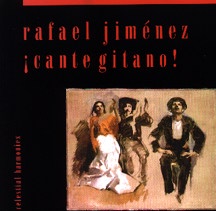

[ Music Index | Metro | Metroactive Central | Archives ]
Flamenco Flames On
Recent Rykodisc re-releases highlight flamenco tradition
By Sam Prestianni
Arguably Europe's most fiery folk-music tradition, flamenco carries a far deeper significance for the native Andalusians of southern Spain. For them, flamenco's profound expression of sorrow and joy is more than an electrifying song and dance form; it's a way of life. Spanish poet Garcia Lorca once wrote that duende, the mysterious, untranslatable emotional charge that gives flamenco its overwhelming power, emanates from "the final blood-filled room of the soul."
Though its origins are widely debated, flamenco's roots seem to date from the 15th and 16th centuries, when Gypsies and other non-Christians fled to the Andalusian mountains to avoid persecution by the newly installed Catholic oligarchy. Through a cross-fertilization of fringe cultures--chiefly of Indian, Arabic, Moorish and Sephardic Jewish descent--Gypsy or gitano flamenco developed as a testament of a proud people's struggle and perseverance against extreme adversity.
By the mid�19th century, the close-knit Gypsy clans had codified a complex system of "laws" for the preservation of flamenco puro (pure flamenco), ushering in a Golden Age of popular and artistic renown which would last until the early 1930s.
Flamenco Puro
In 1940, while touring internationally with noted dancer La Argentina, gitano guitarist Carlos Montoya decided to settle in the United States. Having already broken the laws of flamenco puro by expanding the role of the six-string from accompanist for lead singers and dancers to an occasional solo vehicle, Montoya went on to introduce a full recital of solo guitar to his flamenco repertoire.
Although purists at home derided him, Montoya was embraced by audiences worldwide for his flamboyant innovations, which involved extraordinary speed and fluency in largely improvised performances.
Rykodisc's recent acquisition of the Tradition label and ambitious reissue series has yielded two essential documents of the music: Flamenco! by Montoya and Flamenco España by Bernabe de Moron. One of the finest examples of Montoya's solo artistry in the late '40s, Flamenco! should acquaint younger generations with the modern roots of current innovators such as Paco de Lucia and Tomatito.
Flamenco España, from the 1960s, teams de Moron with a trio of American guitarists and a quartet of distinguished Spanish dancers. With fleet fretwork and stomping heels, this heady program of traditional material presents duende in all its passion and grace.
Vocalist Rafael Jiménez erupts with an equally ecstatic vibrancy on Cante Gitano! Well-versed in the infinite variety of flamenco's fandangos, siguiriyas, soleares and tangos, the 32-year-old Spanish native combines reverence for tradition with original compositional ideas, including the uncommon use of Indian tablas as percussion. Gypsy-flavored tunes such as "Viejando (Traveling)" and "En Alcalá No Reina Alegría (There's No Joy in Alcalá)" cry out with the emotional intensity of raw flamenco.
Nouveau Flamenco
Curiously, the most popular contemporary flamenco artists--the Gipsy Kings and Ottmar Liebert--do not hail from Spain, nor do they play strict flamenco. Liebert's latest, Opium, a two-disc set of original songs with his electric group Luna Negra, uses no flamenco techniques whatsoever. The Cologne-born guitarist, once heralded as "Nouveau Flamenco," creates lush, pristine soundscapes of minimally flourished, Latin-based melodies for easy-listening/New Age somnambulists.
The Gipsy Kings, an exceptional septet of guitarists, vocalists and songwriters from the Reyes and Baliardo gitano clans of France, fuse flamenco's vitality with pop-song formats. Their approach makes the sounds accessible to a huge cosmopolitan fan base (13 million units sold in the past seven years) without debasing the music's integrity.
The evolution continues.
[ Metro | Metroactive | Archives ]
